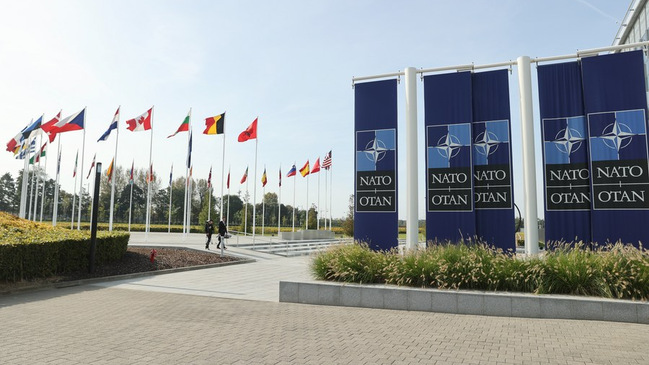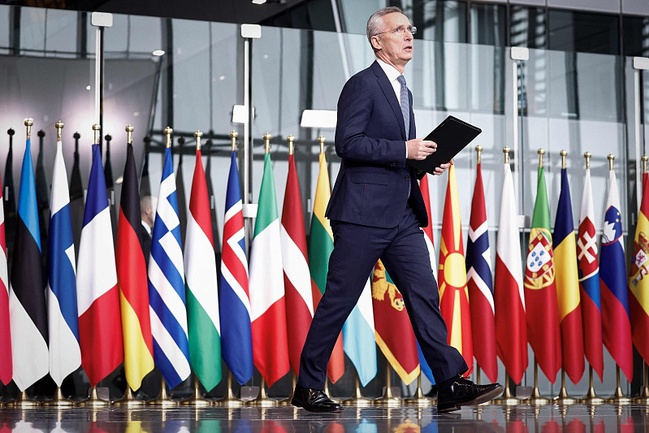
Editor's note: Jian Junbo, a special commentator on current affairs for CGTN, is an associate professor and the deputy director of the Center for China-Europe Relations at Fudan University. He is also the under-secretary-general of the Shanghai Institute for European Studies. The article reflects the author's views and not necessarily those of CGTN.
The meeting of NATO ministers of foreign affairs is being held on April 3 and 4, along with commemorative events marking the organization's 75th anniversary. From a European perspective, NATO is not only the primary pillar of European security but also the greatest obstacle to the integration of European defense.
Why NATO becomes more active after the Cold War
Following the dissolution of the Warsaw Pact, the military alliance opposing NATO at the end of the Cold War, NATO did not disintegrate; instead, it grew stronger.
From an objective standpoint, despite the dissolution of the Warsaw Pact, NATO's historical adversary, the strategic threats confronting the West – represented by Europe and America – persisted. These threats encompass Russia, armed with nuclear capabilities, which has a longstanding history of conflict with Europe. Furthermore, there is a noticeable uptick in non-traditional security challenges.
From a subjective viewpoint, NATO serves as a crucial tool for the U.S. to uphold its military hegemony and as a means to constrain Europe. Meanwhile, Europe perceives Russia as an enduring threat post-Cold War, necessitating NATO's continued role in balancing security dynamics internally. Simultaneously, both Europe and the U.S. rely on NATO as a unifying force to fortify the transatlantic partnership and safeguard the Western liberal international order.
Over time, NATO has continued to evolve and adapt. It has expanded its geographical reach – through multiple rounds of enlargement, NATO has brought nearly all European countries under its umbrella. Besides, there has been an expansion in its operational domains – through strategic adjustments, NATO has broadened its focus beyond purely military concerns to include a range of non-traditional security areas such as energy and counter-terrorism.
How Europe is being constrained by NATO
Firstly, NATO's presence presents significant challenges to the integration of European defense. Despite strong efforts, particularly from countries like France, to advance this integration process, they encounter formidable obstacles, primarily due to budget constraints. Many European nations continue to struggle to meet the 2 percent of their annual GDP target for defense spending, let alone allocate additional funds to support European defense integration initiatives.
Additionally, the U.S. strategically opposes the development of independent European defense capabilities and is reluctant to see the existence of a European defense market that excludes American participation. This opposition from NATO and the U.S. leads to internal discord within Europe, hindering the formation of a consensus on European defense integration.
Furthermore, amidst the Russia-Ukraine conflict, European defense integration has experienced a downturn. This conflict has spurred increased cooperation within NATO among the United States and other European member states. French President Emmanuel Macron has noted that NATO has revived due to the Russia-Ukraine conflict.
In this context, European nations are allocating substantial portions of their national budgets to tackle this conflict and its associated challenges. Politically, Europe also finds it difficult to actively promote the process of European defense integration, as it could potentially strain the military alliance between Europe and the U.S.
Moreover, Europe's pursuit of strategic autonomy has experienced a temporary slowdown. Given the strengthening military ties between Europe and the U.S., Europe's broader aspirations for strategic autonomy are somewhat constrained.
Now European defense integration is being hampered, yet it remains the cornerstone of European strategic autonomy. True political independence can only be achieved by attaining security independence. At the same time, Europe's progress in economic and trade realms must align with U.S. expectations to uphold the solidarity of the transatlantic alliance.

Whether Europe can break free from NATO and become independent
If Europe wishes to minimize its constraints by NATO, it needs to make the following efforts.
Increased investment is imperative. The EU should enhance its current framework by developing improved financing mechanisms for defense integration and exploring wider funding avenues. More importantly, it must prioritize the revitalization of the European economy, resist trade protectionism, and establish crucial groundwork for accessing supplementary funding sources.
Moreover, reforming Europe's strategic culture entails consolidating the positions of EU member states on defense integration. Presently, there is a lack of consensus among European countries regarding the relationship between European defense integration and NATO. It is essential for the EU to engage in extensive discussions to establish a shared position, fostering a more cohesive security strategy culture.
Apart from that, establishing a balanced European defense industry market is crucial. France, being a key player in defense research and weapons production within Europe, stands poised to reap substantial economic rewards from European defense integration. Nonetheless, this prospect might stir dissatisfaction among other EU member states.
The key challenge lies in ensuring fair access for all member states to the European defense industry market, thereby enabling them to share the benefits equitably. The extent to which this fairness is achieved will significantly influence the outcome of European defense integration.
In addition, the systematic establishment of defense integration holds great significance. This entails ensuring consistency among the key mechanisms driving integration forward. At the supra-national level within the EU, there is guidance from the Common Foreign and Security Policy, supported by the External Action Service and participation of the European Defense Agency. At the intergovernmental level, there is the Permanent Structured Cooperation, where both EU and non-EU members voluntarily participate in defense collaboration.
Consequently, there is a need to consolidate the dominant forces within the European defense integration process. Also, it is imperative to enhance coherence among mechanisms across various defense functional areas. For instance, without the ability to jointly procure weapon systems, achieving interoperability becomes challenging. Hence, the alignment of operational mechanisms across diverse functional domains is paramount.
Nevertheless, the future of European defense integration hinges on effectively managing its relationship with NATO and tackling various internal issues, including funding, security strategy culture, and institutional unity within Europe. Only by addressing these challenges can substantial progress be made in European defense integration.






